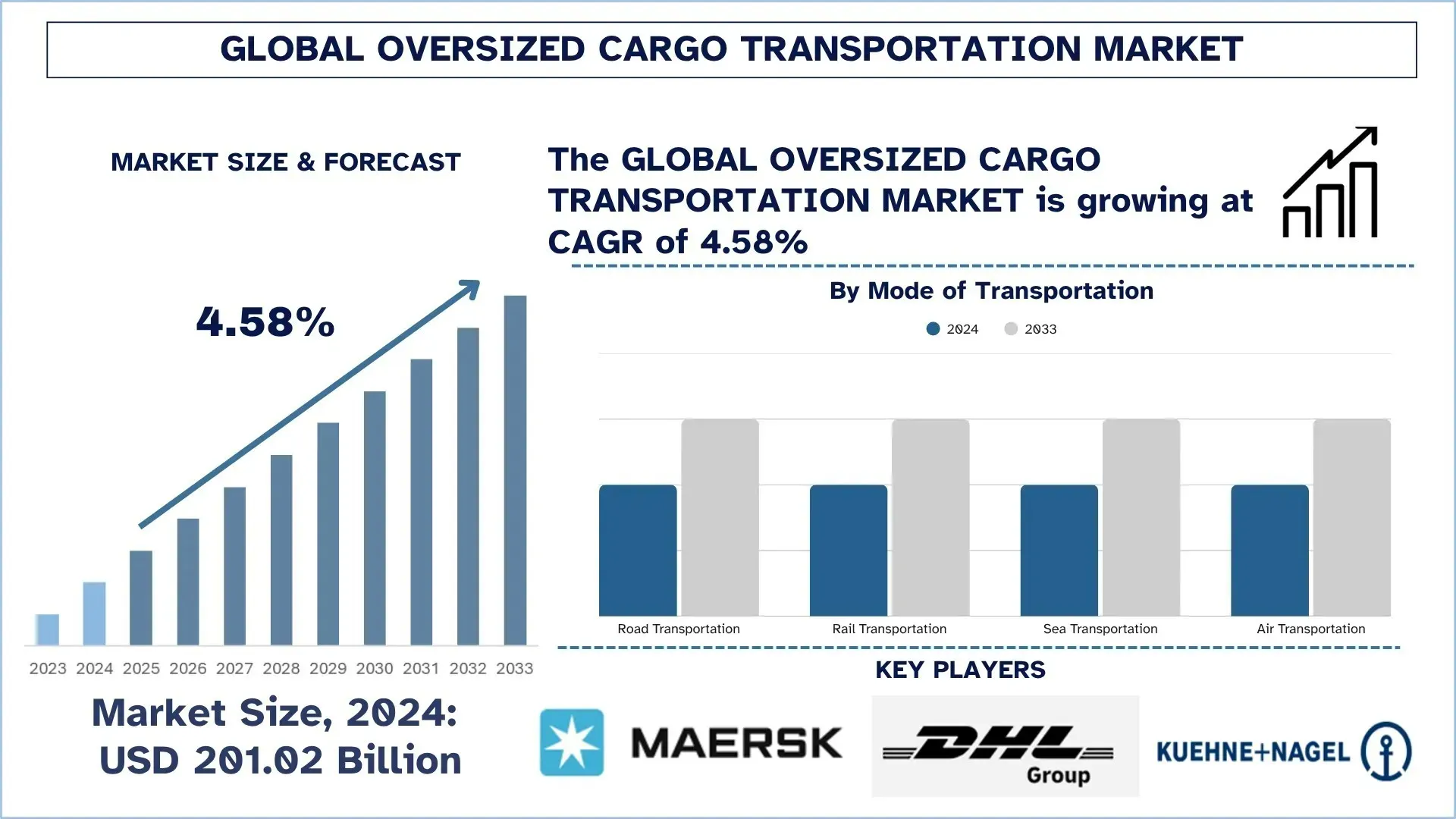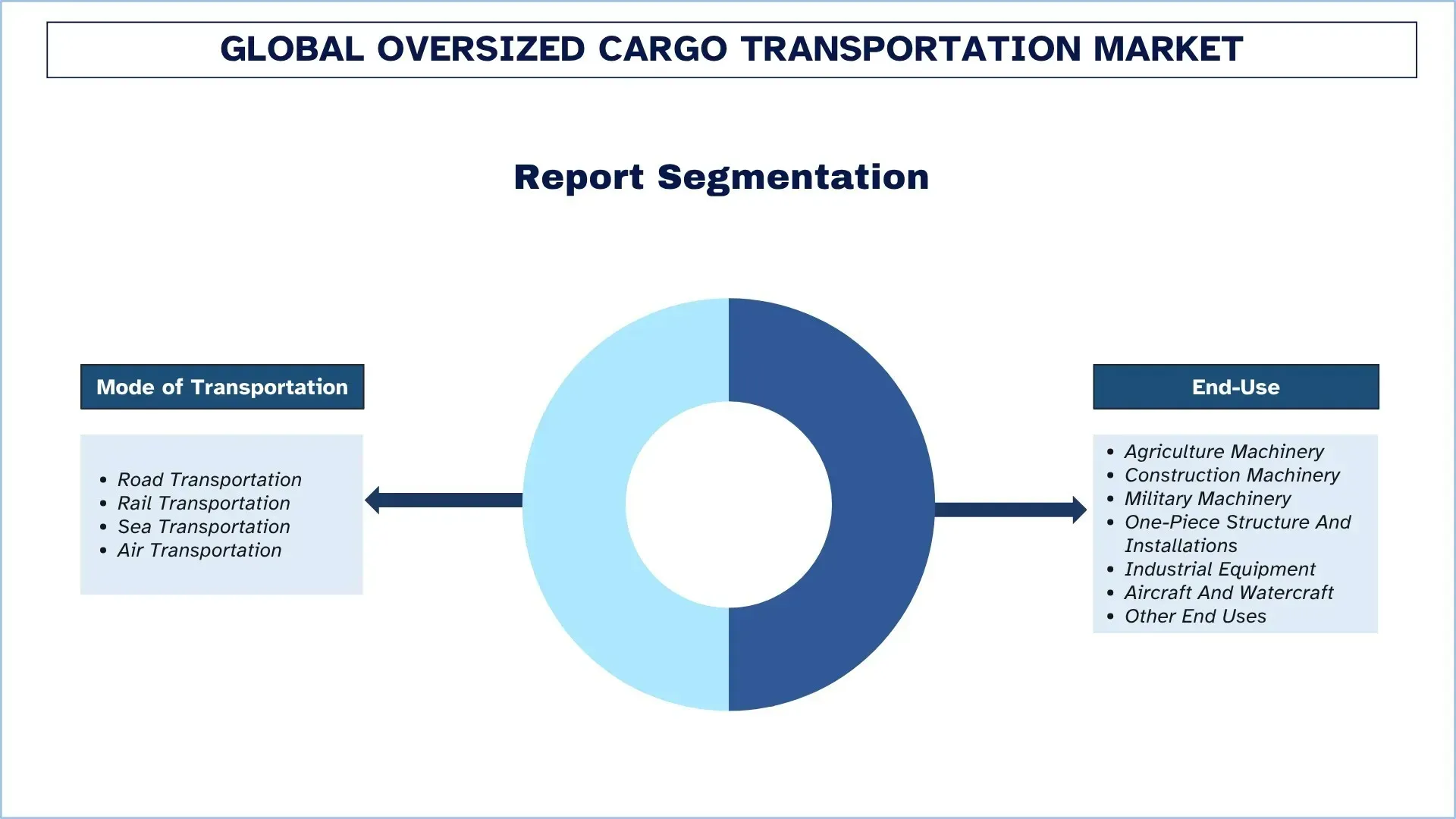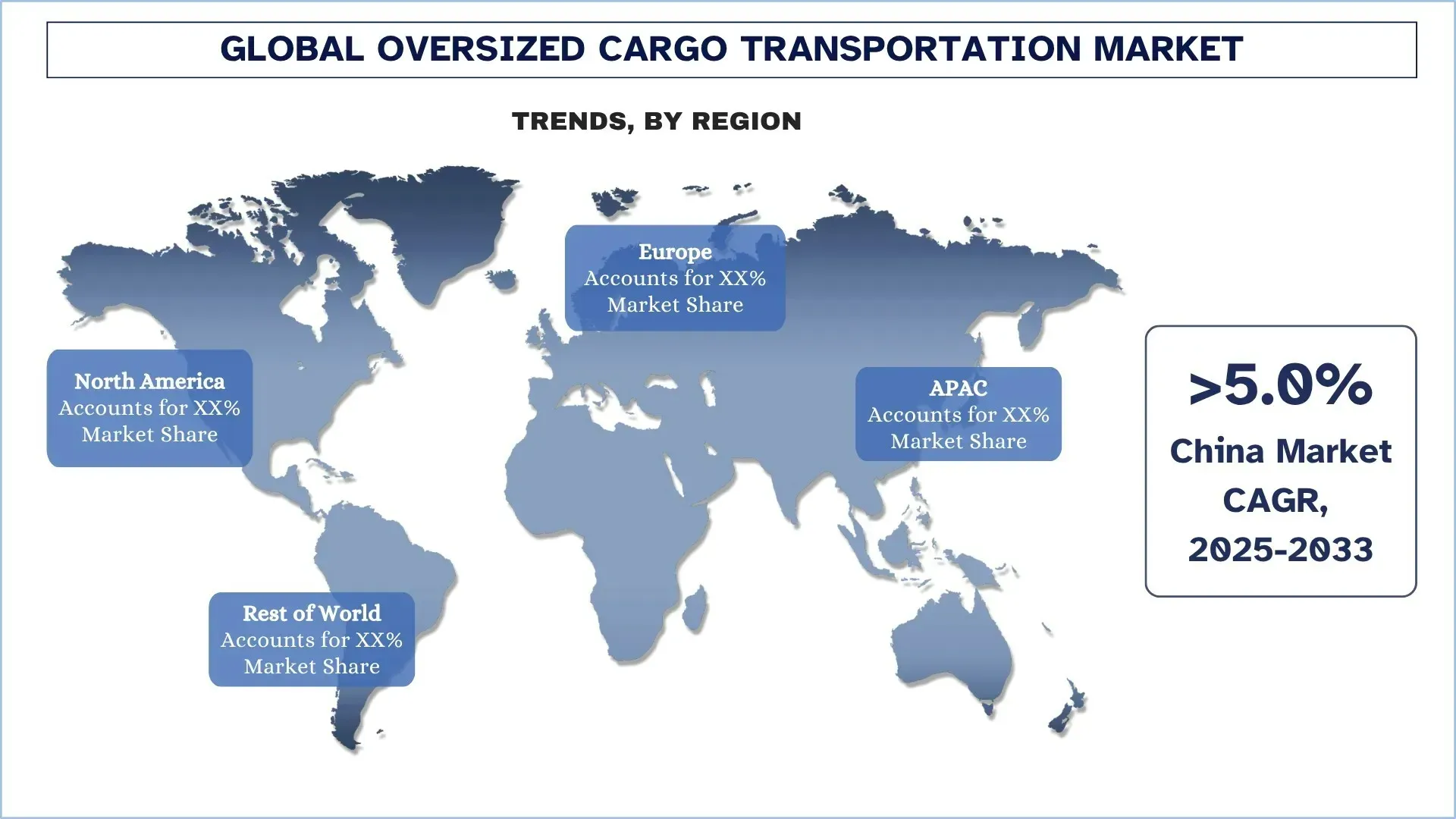- Home
- About Us
- Industry
- Services
- Reading
- Contact Us
Oversized Cargo Transportation Market: Current Analysis and Forecast (2025-2033)
Emphasis on Mode of Transportation (Road Transportation, Rail Transportation, Sea Transportation, and Air Transportation); End-Use (Agriculture Machinery, Construction Machinery, Military Machinery, One-Piece Structure and Installations, Industrial Equipment, Aircraft and Watercraft, and Other End Uses); and Region/Country

Global Oversized Cargo Transportation Market Size & Forecast
The Global Oversized Cargo Transportation Market was valued at USD 201.02 billion in 2024 and is expected to grow at a CAGR of around 4.58% during the forecast period (2025–2033F), driven by the rapid urbanization, large-scale infrastructure projects, and renewable energy expansion.
Oversized Cargo Transportation Market Analysis
The cargo transportation of oversized items worldwide has been steadily increasing due to the parallel development of renewable energy and global infrastructure. The key factor is the global shift to sustainable energy, which requires the transportation of huge and indivisible components. The logistical transport of very long turbine blades, heavy nacelles, and large-diameter tower sections may be a part and parcel of this transition; wind farms require transporting these components over long distances from manufacturing centers to usually remote installation sites. The heavy-lift transport requirements have been established permanently, and with a niche market due to this single industry. At the same time, the high rate of infrastructure development, particularly in developing economies, drives the need to relocate large industrial machinery, construction tools, and prefabricated structural blocks. Globalization of supply chains implies that these parts are sometimes produced in one place and assembled elsewhere, necessitating complicated and multimodal transportation strategies involving special ships, trailers, and aircraft.
Global Oversized Cargo Transportation Market Trends
This section discusses the key market trends that are influencing the various segments of the global oversized cargo transportation market, as found by our team of research experts.
Integration of AI and IoT in Logistics Operations
The incorporation of Artificial Intelligence (AI) and the Internet of Things (IoT) in logistics operations is one of the key trends currently reshaping the oversized cargo transportation market. The logistics market is increasingly adopting these technological advancements to improve efficiencies, advanced revenue, and increase safety. The traditional transportation model can involve excessive levels of manual process controls and little transparency into shipment status, which typically leads to inefficiencies and delays. When logistics incorporate AI and/or IoT into their operations, they often expand their route planning process, monitor conditions of their cargo in real-time, and plan ahead their maintenance needs, which ultimately often leads to a smoother and more dependable provision of deliveries. Furthermore, a company that utilizes AI and IoT is better able to facilitate the tracking of oversized cargo, resulting in greater visibility into the shipment movement along the supply chain and increasing the process of proactive decision-making. Fuel consumption and carbon emissions can also be reduced due to more efficient/durable management of fuel consumption, route management, and fleet management through the use of this technology. As global demand continues to increase for oversized cargo, driven by industry growth in construction, renewable energy, and manufacturing, the responsibilities of AI and IoT can only increase to bring further improvements to the sustainability of heavy lift goods transportation.
Oversized Cargo Transportation Industry Segmentation
This section provides an analysis of the key trends in each segment of the global oversized cargo transportation market report, along with forecasts at the global, regional, and country levels for 2025-2033.
The Road Transportation Segment Market Dominates the Oversized Cargo Transportation Market
By Mode of Transportation, the global oversized cargo transportation market is segmented into Road, Rail, Sea, and Air Transportation. In 2024, the road transportation segment dominated the market and is anticipated to continue its leadership throughout the forecast period. The road transportation sector is expanding because it is the only mode that ensures final-mile delivery to often distant project areas, such as wind farms or construction sites. Global investments in renewable energy and infrastructure contribute to this dominance because they involve the transfer of huge parts of shipments in the ports or railheads to the final destination. Moreover, progress in technology also plays a major role. With the creation of more advanced modular trailers, self-propelled platforms, and improved hydraulic systems, the transportation of heavy and more complicated loads can now be done safely and efficiently. Road transport is the omnipresent and elastic foundation of the bloated logistics chain, owing to the possibility of overcoming the obstacles of legal and physical routes via route planning.
The Construction Machinery Segment held the Largest Market Share in the Oversized Cargo Transportation Market.
By End-Use, the global oversized cargo transportation market is segmented into Agriculture Machinery, Construction Machinery, Military Machinery, One-Piece Structure and Installations, Industrial Equipment, Aircraft and Watercraft, and Other End Uses. In 2024, the construction machinery segment dominated the market and is anticipated to continue its leadership throughout the forecast period. The development of this segment is further promoted by unparalleled investment in infrastructure development worldwide, such as bridges, dams, and urban developments. This boom necessitates the transport of huge machinery such as cranes, bulldozers, and piling machinery by the manufacturers to the job sites. Moreover, transport by road and sea can also be unique due to its scalability in this sector. Another major driver is the upsurge in the trend of modular construction, whereby large pre-assembled modules are transported. The necessity to improve infrastructure worldwide predetermines the maintenance of the leading role of this segment, with industrial equipment and wind energy elements also playing an important role in market growth.

Asia Pacific Dominated the Global Oversized Cargo Transportation Market
Asia-Pacific dominated the global oversized cargo transportation market in 2024 and is expected to maintain its leadership throughout the forecast period. The main factors behind this dominance are high investments in infrastructure and renewable energy, especially in China and India. The ongoing industrialization of the region, the development of its ports and logistics systems, and the creation of large manufacturing facilities of wind turbine components and heavy machinery provide a permanent demand. The governments of the region's countries are actively investing in large-scale, long-term projects within frameworks like the Belt and Road in China, which involves constructing cross-border infrastructure that will require massive heavy-lift logistics. Likewise, ambitious national goals on solar and wind energy are providing an endless stream of projects within the country that rely solely on the capacities of the oversized cargo ship.
China held a dominant Share of the Asia Pacific Oversized Cargo Transportation Market in 2024
The Chinese oversized cargo transportation market is growing smoothly, which is promoted by the high development rates of renewable energy, huge construction projects, and the modernization of industry. The increasing need for specialized logistics services to transport large parts of wind turbine blades, transformers, and prefabricated structures demanded to support energy and construction projects has been identified as one of the key drivers. The high renewable energy targets that China has set and the continued investment in the electric vehicle manufacturing sector have made the necessity of having the ability to transport heavy and long distances very high. Also, the transport infrastructure is constantly being improved with new highways, ports, and rail networks that are improving the efficiency and connectedness of regions. Use of smart logistics technologies, artificial intelligence, IoT, and real-time tracking systems, among others, is also enhancing safety in the operations and cutting costs.

Oversized Cargo Transportation Industry Competitive Landscape
The global oversized cargo transportation market is competitive, with several global and international market players. The key players are adopting different growth strategies to enhance their market presence, such as partnerships, agreements, collaborations, new product launches, geographical expansions, and mergers and acquisitions.
Top Oversized Cargo Transportation Companies
Some of the major players in the market are A.P. Moller – Maersk, DHL Group, Kuehne+Nagel, C.H. Robinson, DSV, Kintetsu World Express, Inc., DB Port Szczecin Sp. z o.o, LANDSTAR SYSTEM, INC., Orient Overseas Container Line Limited, and Barnhart.
Recent Developments in the Oversized Cargo Transportation Market
In September 2024, DP World, a UAE-based logistics company, acquired Cargo Services Far East Ltd for an undisclosed amount. This acquisition aims to enhance DP World's capabilities in retail and fashion logistics, as well as expand its airfreight business. Cargo Services Far East Ltd is a China-based logistics solutions provider company.
In January 2023, A.P. Møller-Mærsk A/S, a Denmark-based shipping and logistics company, acquired Martin Bencher Group, a Denmark-based freight forwarder with a focus on big and oversized cargo, for an undisclosed sum. With the acquisition, Maersk aims to increase its project logistics capabilities, which include moving huge, heavy, and complicated things like wind turbines, oil rigs, and other industrial equipment.
Global Oversized Cargo Transportation Market Report Coverage
Report Attribute | Details |
Base year | 2024 |
Forecast period | 2025-2033 |
Growth momentum | Accelerate at a CAGR of 4.58% |
Market size 2024 | USD 201.02 Billion |
Regional analysis | North America, Europe, APAC, Rest of the World |
Major contributing region | Asia Pacific is expected to dominate the market during the forecast period. |
Key countries covered | U.S., Canada, Germany, U.K., Spain, Italy, France, China, Japan, and India |
Companies profiled | A.P. Moller – Maersk, DHL Group, Kuehne+Nagel, C.H. Robinson, DSV, Kintetsu World Express, Inc., DB Port Szczecin Sp. z o.o, LANDSTAR SYSTEM, INC., Orient Overseas Container Line Limited, and Barnhart |
Report Scope | Market Trends, Drivers, and Restraints; Revenue Estimation and Forecast; Segmentation Analysis; Demand and Supply Side Analysis; Competitive Landscape; Company Profiling |
Segments Covered | By Mode of Transportation; By End-Use; By Region/Country |
Reasons to Buy Oversized Cargo Transportation Market Report:
The study includes market sizing and forecasting analysis confirmed by authenticated key industry experts.
The report briefly reviews overall industry performance at a glance.
The report covers an in-depth analysis of prominent industry peers, primarily focusing on key business financials, type portfolios, expansion strategies, and recent developments.
Detailed examination of drivers, restraints, key trends, and opportunities prevailing in the industry.
The study comprehensively covers the market across different segments.
Deep dive regional-level analysis of the industry.
Customization Options:
The global oversized cargo transportation market can further be customized as per the requirements or any other market segment. Besides this, UnivDatos understands that you may have your own business needs; hence, feel free to contact us to get a report that completely suits your requirements.
Table of Content
Research Methodology for the Global Oversized Cargo Transportation Market Analysis (2023-2033)
We analyzed the historical market, estimated the current market, and forecasted the future market of the global oversized cargo transportation market to assess its application in major regions worldwide. We conducted exhaustive secondary research to gather historical market data and estimate the current market size. To validate these insights, we carefully reviewed numerous findings and assumptions. Additionally, we conducted in-depth primary interviews with industry experts across the oversized cargo transportation value chain. After validating market figures through these interviews, we used both top-down and bottom-up approaches to forecast the overall market size. We then employed market breakdown and data triangulation methods to estimate and analyze the market size of industry segments and sub-segments.
Market Engineering
We employed the data triangulation technique to finalize the overall market estimation and derive precise statistical numbers for each segment and sub-segment of the global oversized cargo transportation market. We split the data into several segments and sub-segments by analyzing various parameters and trends, including mode of transportation, end-use, and regions within the global oversized cargo transportation market.
The Main Objective of the Global Oversized Cargo Transportation Market Study
The study identifies current and future trends in the global oversized cargo transportation market, providing strategic insights for investors. It highlights regional market attractiveness, enabling industry participants to tap into untapped markets and gain a first-mover advantage. Other quantitative goals of the studies include:
Market Size Analysis: Assess the current market size and forecast the market size of the global oversized cargo transportation market and its segments in terms of value (USD).
Oversized Cargo Transportation Market Segmentation: Segments in the study include areas of mode of transportation, end-use, and regions.
Regulatory Framework & Value Chain Analysis: Examine the regulatory framework, value chain, customer behavior, and competitive landscape of the oversized cargo transportation industry.
Regional Analysis: Conduct a detailed regional analysis for key areas such as Asia Pacific, Europe, North America, and the Rest of the World.
Company Profiles & Growth Strategies: Company profiles of the oversized cargo transportation market and the growth strategies adopted by the market players to sustain the fast-growing market.
Frequently Asked Questions FAQs
Q1: What is the global oversized cargo transportation current market size and its growth potential?
The global oversized cargo transportation market was valued at USD 201.02 billion in 2024 and is expected to grow at a CAGR of 4.58% during the forecast period (2025-2033).
Q2: Which segment has the largest share of the global oversized cargo transportation market by mode of transportation?
The road transportation segment dominated the market and is anticipated to continue its leadership throughout the forecast period. The road transportation sector is expanding because it is the only mode that ensures final-mile delivery to often distant project areas, such as wind farms or construction sites. Global investments in renewable energy and infrastructure contribute to this dominance because they involve the transfer of huge parts of shipments in the ports or railheads to the final destination.
Q3: What are the driving factors for the growth of the global oversized cargo transportation market?
• Rapid Urbanization and Large-scale Infrastructure Projects Growth: Increasing urban development and industrial expansion worldwide are driving demand for transporting heavy machinery, prefabricated structures, and equipment essential for large infrastructure projects.
• Renewable Energy Expansion: The global shift toward renewable energy, especially wind and solar, requires transporting massive components like turbines and towers, fueling strong demand for specialized oversized cargo logistics.
• Innovations in Logistics, such as Digital Twin-Enabled Route Modeling: The use of digital twin technology enhances route planning accuracy, minimizes risks, optimizes load distribution, and ensures safer, cost-effective transport of large and complex cargo.
Q4: What are the emerging technologies and trends in the global oversized cargo transportation market?
• Integration of AI and IoT in Logistics Operations: AI and IoT integration enable real-time cargo monitoring, predictive maintenance, and route optimization, improving operational efficiency, transparency, and sustainability in oversized cargo transport.
• Intermodal Transport Solutions: Combining road, rail, sea, and air modes ensures flexibility, cost efficiency, and seamless long-distance movement of oversized cargo across complex global supply chains
Q5: What are the key challenges in the global oversized cargo transportation market?
egulatory Complexities: Varying regional transport regulations, permits, and route restrictions create compliance hurdles, delays, and additional costs for operators handling cross-border oversized cargo shipments.
• Infrastructure Limitations: Inadequate road capacity, bridge strength, and port handling infrastructure in developing regions often restrict the movement of large cargo, causing inefficiencies and increased transit time.
Q6: Which region dominates the global oversized cargo transportation market?
Asia-Pacific dominated the global oversized cargo transportation market in 2024 and is expected to maintain its leadership throughout the forecast period. The main factors behind this dominance are high investments in infrastructure and renewable energy, especially in China and India. The ongoing industrialization of the region, the development of its ports and logistics systems, and the creation of large manufacturing facilities of wind turbine components and heavy machinery provide a permanent demand.
Q7: Who are the key players in the global oversized cargo transportation market?
Some of the key companies include:
• A.P. Moller - Maersk
• DHL Group
• Kuehne+Nagel
• C.H. Robinson
• DSV
• Kintetsu World Express, Inc
• DB Port Szczecin Sp. z o.o
• LANDSTAR SYSTEM, INC.
• Orient Overseas Container Line Limited
• Barnhart
Q8: What role do partnerships and collaborations play in the oversized cargo transportation market's growth?
• Strategic Alliances with Technology Providers: Collaborations with logistics technology firms are enabling the adoption of AI, IoT, and digital twin solutions, improving route planning, safety, and real-time cargo visibility.
• Joint Ventures with Infrastructure and Energy Companies: Partnerships with renewable energy developers, construction firms, and heavy equipment manufacturers are expanding the market for specialized transport services and long-haul logistics.
• Public-Private Partnerships (PPPs): Coordination between governments and private logistics operators is boosting large-scale infrastructure projects, developing transport corridors, and modernizing ports and highways to support heavy-lift operations.
Q9: How is the global supply chain affecting the oversized cargo transportation market?
• Supply Chain Diversification: Companies are increasingly diversifying logistics routes and partners to mitigate risks from geopolitical tensions and ensure smooth transportation of oversized equipment across continents.
• Digital Supply Chain Integration: Advanced tracking systems and digital freight platforms are improving coordination among carriers, ports, and customs, leading to reduced transit delays and enhanced transparency.
• Regional Manufacturing and Assembly Hubs: The rise of regional production centers for renewable energy and industrial components is creating localized demand for oversized cargo logistics, optimizing costs and reducing environmental impact.
Related Reports
Customers who bought this item also bought










